

MAKE IT then MOVE IT: animated GIF. 5 Ways to Make AWESOME Plans for a New Makerspace. MakerSpace/Design Thinking - giveitaway.net. Beginner’s Guide to Maker-ize An Elementary Classroom – HonorsGradU. When most penny-pinching, time-crunched, and exhausted teachers hear about lofty ideas like the MakerSpace movement in education, they are likely to dismiss it as another passing and impractical fad.

However, the more we investigate, the more convinced we are that there are practical–and profoundly meaningful–ways for teachers to implement its ideals, even in an elementary school classroom. Benefits of Maker Spaces “Makerspaces come in all shapes and sizes, but they all serve as a gathering point for tools, projects, mentors and expertise. A collection of tools does not define a Makerspace. Rather, we define it by what it enables: making.”
They cultivate creativity. (Remember Caine’s Arcade? How to Build Your Makerspace. Learning by making has been around since long before edtech—just think about what the adventurous explorers or intrepid settlers of yore would have thought of "Do-It-Yourself.
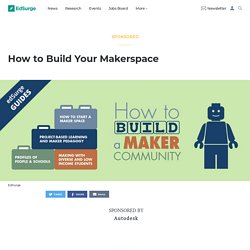
" But with thousands of kid-friendly tech tools and a whole World Wide Web of resources out there, creative, interesting opportunities for learning-by-making abound for everyone. Okay, so with all those resources, where should you start to build a makerspace? Here at EdSurge, we've rolled up our sleeves, put on our protective goggles, and built a Maker Guide from scratch, just for you. Read on for ideas from the educators and entrepreneurs who think making 24/7, including what is involved with project-based learning and making in the classroom and tried-and-true lessons from the field on starting your makerspace. Making on a budget? Expect the Miraculous. A few weeks ago, Gretchen Thomas, UGA instructional technology teacher, emailed me about a possible collaboration on the UGA campus.
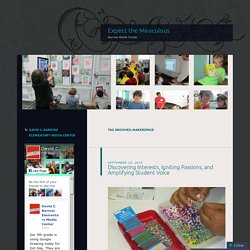
She wanted to bring her Maker Dawgs class to the UGA Tate Center Plaza to host a popup makerspace. The idea would be to have a variety of maker tools available for UGA students to try on the spot. She wondered if I had students who might join them. Without hesitation, I said yes and we started the logistics. The more we planned, the bigger the trip got. Sylvia's Super-Awesome Maker Show! S4E1 Mini S3E1 Mini S2E8 Mini.
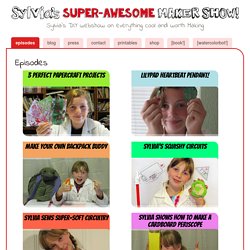
A Librarian's Guide to Makerspaces: 16 Resources. "There were more than 135 million adult makers, more than half of the total adult population in America, in 2015.
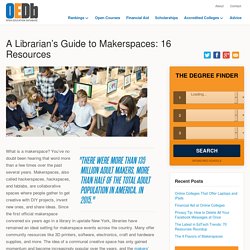
" What is a makerspace? You’ve no doubt been hearing that word more than a few times over the past several years. Makerspaces, also called hackerspaces, hackspaces, and fablabs, are collaborative spaces where people gather to get creative with DIY projects, invent new ones, and share ideas. Since the first official makerspace convened six years ago in a library in upstate New York, libraries have remained an ideal setting for makerspace events across the country. Many offer community resources like 3D printers, software, electronics, craft and hardware supplies, and more. There were more than 135 million adult makers, more than half of the total adult population in America, in 2015. Tinkering Space Interview: Megan Schiller. Today I’m joined by Megan Schiller of The Art Pantry, as part of our ongoing series of inspiring conversations that center on how to set up creativity hubs, or tinkerspaces.
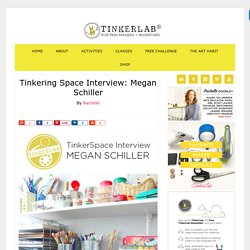
If you’re scratching your head because you can’t figure out where to put your child’s art materials, want to turn your laundry room into an art zone, or tend to shift furniture to make room for creative supplies, these interviews are sure to give you food for thought. Megan Schiller is a creative parent with an impressive background in art education, who now runs an amazing online kid-friendly art store called The Art Pantry where she also consults families on how to set up their very own Art Pantry (check out her very generous giveaway at the end of this post).
I’ve drooled over pictures of Megan’s child-friendly tinkering space in her Instagram feed and also on her blog, and I asked her if she’d be so kind to share it with us today. Yay! We’re in for treat. Can you tell us about your family? Great question! Creating-a-design-challenge-tip-sheet.pdf. RAFT Bay Area - Resource Area For Teaching. RAFT Needs Your Support Join RAFT and Silicon Valley Community Foundation for Silicon Valley Gives, a one-day event to bring community and nonprofits together in a big way.
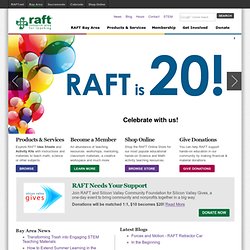
Donations will be matched 1:1, $10 becomes $20! Read More It’s a day of unprecedented online giving on May 6th. Apollo 13 (7/11) Movie CLIP - Square Peg in a Round Hole (1995) HD. What Crazy Tech Idea Could Become Real? How to Use the “4 C’s” Rubrics. This excerpt appears in the Buck Institute for Education's book, "PBL for 21st Century Success: Teaching Critical Thinking, Collaboration, Communication, Creativity.
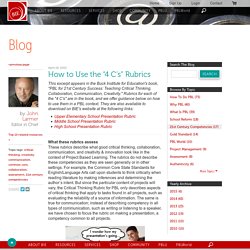
" The Design Process - A model for Digital Design Success. DTtoolkit v1 062711. 27 Ways to Inspire Students to Innovate (Infographic) Via MindShift.
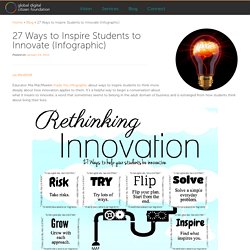
2013 Technology Outlook for STEM+ Education - The New Media Consortium. The Technology Outlook for STEM+ Education 2013-2018: An NMC Horizon Project Sector Analysis was released as a collaborative effort between the New Media Consortium (NMC), the Centro Superior para la Enseñanza Virtual (CSEV), Departamento de Ingeniería Eléctrica, Electrónica y de Control at the Universidad Nacional de Educación a Distancia (UNED), and the Institute of Electrical and Electronics Engineers Education Society (IEEE).

This report will inform education leaders about significant developments in technologies supporting STEM+ (science, technology, engineering, and mathematics) education. Twelve emerging technologies are identified across three adoption horizons over the next one to five years, as well as key trends and challenges expected to continue over the same period, giving educators, administrators, and policymakers a valuable guide for strategic technology planning across STEM+ education.
The Other 21st Century Skills. Many have attempted to identify the skills important for a learner today in this era of the 21st century (I know it is an overused phrase). I have an affinity towards the skills identified by Tony Wagner: Critical thinking and problem-solvingCollaboration across networks and leading by influenceAgility and adaptabilityInitiative and entrepreneurialismEffective oral and written communicationAccessing and analyzing informationCuriosity and imagination Today I viewed a slideshow created by Gallup entitled, The Economics of Human Development: The Path to Winning Again in Education. Here are some slides from this presentation. HS.Engineering Design. Who cares about the Platform - Let's just focus on 21st Century Skills. What skills will you need to succeed in the future? Top 10 skills for the successful 21st-century worker Leadership. 7 Skills students need for their future.
What is Connected Learning. Ninth-grader Charles Raben has seen first-hand that by connecting the many spheres of his life -- peers, interests and academic pursuits -- new learning experiences can and will present themselves in both organized and unstructured ways. In the summer of 2012, Charles utilized his photography skills and the petition website Change.org to capture and share the story of Jerry Delakas, a longtime local newsstand operator who was in danger of losing his New York City license over a technicality. Using Gaming Principles to Engage Students.
Game designers understand how to make games memorable and "sticky" in the sense that, even when you aren't playing the game, you're still thinking about solving its problems and puzzles. As teachers, how might we make our projects and content as sticky as games? How can we engage kids in thoughtful learning even after they leave the classroom? Here are game designers' top five secrets and some tips on using these same game dynamics to make learning in your classroom as addictive as gaming. 1.
The Story Dynamic: Wrap Them Up in the Story. What’s Up with STEM for 2015? A MiddleWeb Blog My fingers are crossed for 2015 as the best STEM year ever! I’ve been looking around to see what directions STEM programs seem to be taking this year. At first glance, it appears that deciding what a STEM program should look like is an ongoing conundrum for the K-12 education world. I decided to scrutinize what’s being described as “STEM” these days using resources from the National Academies and the American Society for Engineering Education, as well as my own work with the Engaging Youth through Engineering project.
If you’d like to have a good look at some basic STEM principles, you might start with these three publications. . ► Successful STEM Education Programs (National Research Council) Design Thinking Process - The Nueva Design Institute. Autodesk Launches Tinkerplay App, Making 3D Modeling & Printing Easy & Fun. We all know how important 3D modeling and printing will be in the years to come. If I had children, I would be teaching them at the earliest age possible how to model with CAD software, and ultimately how to use a 3D printer, as the world our children will be entering as adults will likely be foreign to what we are all familiar with today. A Design Thinking Workshop for Kids. Web Tools to Enhance Kids Creativity. STEM to STEAM: Resource Roundup.
Gamestorming. iOS Game Development Tutorials. Gamestar Mechanic. TechNewsKids. Kids Learning Skills and Being Awesome. - DIY. Projects. 3D Printers Add a New Dimension to Classrooms. When Ron Smith first saw a 3D printer in action, he knew the device belonged in his Engineering and Metal Fabrication program at Nestucca Junior/Senior High School in Cloverdale, Ore. Find, create and share lesson plans and teaching tools to empower your classroom. How to Use Recycled Tech Devices as Learning Tools. The idea of dissection in the classroom is nothing new. Useful Tools Students Can Use to Create 3D Models (Work on Chromebooks too) January 21, 2015 Below are two useful tools you can use with your students to create 3D models on the cloud. A Glimpse into the future of learning.
The Importance of Thinking In- and Out-of-the-Box. Designing Personalized Learning Experiences. The phrase “personalized learning” gets tossed around a lot in education circles. Sometimes it’s used in the context of educational technology tools that offer lessons keyed to the academic level of individual students. Maker Education. How the Maker Movement Is Moving into Classrooms. The Maker movement is a unique combination of artistry, circuitry, and old-fashioned craftsmanship. Certainly, learning by doing or "making" has been happening since our ancestors refined the wheel.
EDUCATIONAL MAKERSPACES. Editor’s Note: This article, reprinted from the June 2014 issue of Teacher Librarian: The Journal for School Library Professionals, is a thoughtful and insightful examination of the philosophy and pedagogical underpinnings of the maker movement. UK schools to make space apps with interstellar Raspberry Pi computers. UK Space Agency astronaut Tim Peake will take two Raspberry Pi computers on his next space mission, in the hope that UK pupils will create their own app or experiment that can be deployed on the International Space Station. Peake will fly two “Astro Pi” maker-boards, which have been kitted with sensors, to the space station when he begins his six-month mission. Primary and secondary school children will compete to develop an idea for an application, which if successful, will be developed with the help of the Astro Pi, CGI and Raspberry Pi Foundation, who will code their idea.
Students teaching students IT. 11 Inspiring TED Talks for Modern Educators. Learning Pathways: Descriptive or Prescriptive? Teaching Coding in Class: 17 Apps to Try. 10 places where anyone can learn to code. Coding for kids. Upgrade Your Brain: Resources for Coding Beginners. How to Get Girls Into Coding. 3 Ways Coding and Gaming Can Enhance Learning.
Mindy Slaughter - Coding in Elementary.